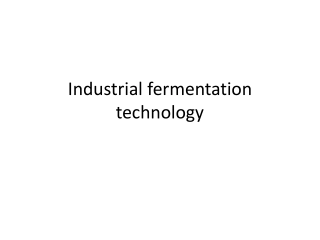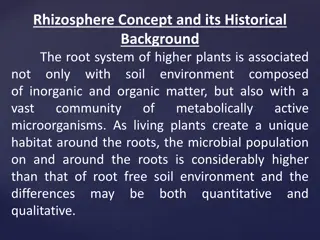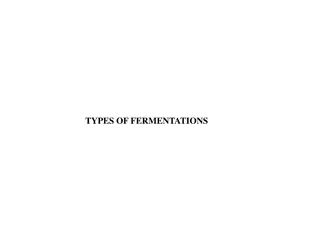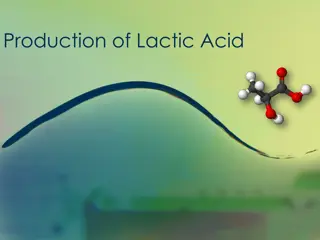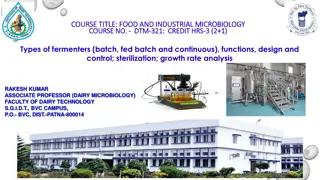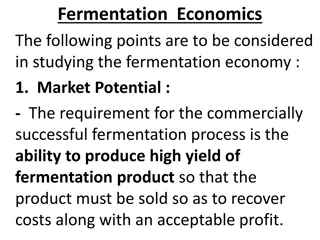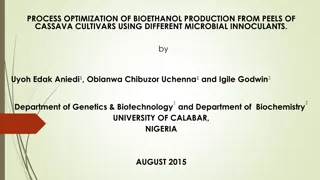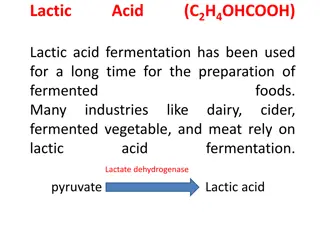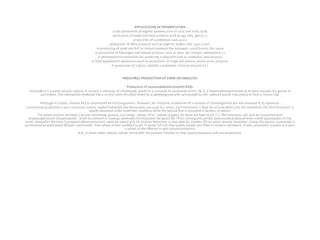Industrial Production of Citric Acid and Microbial Fermentation
Industrial production of citric acid has evolved from extraction processes to microbial fermentation, offering various industrial applications. Citric acid is utilized as an acidulant in food and pharmaceutical industries, a chelating agent in tanning, and a flavor enhancer in carbonated beverages. Different fermentation methods like surface culture and submerged culture are employed to produce citric acid using microorganisms like Aspergillus niger.
Download Presentation

Please find below an Image/Link to download the presentation.
The content on the website is provided AS IS for your information and personal use only. It may not be sold, licensed, or shared on other websites without obtaining consent from the author. Download presentation by click this link. If you encounter any issues during the download, it is possible that the publisher has removed the file from their server.
E N D
Presentation Transcript
Unit II Industrial Productions Mr. S. N. Mendhe Department of Microbiology, Shri Shivaji Science and Arts College, Chikhli
Industrial Production of Industrial Production of Citric Acid Citric Acid Citric acid occurs naturally as a component of many fruits. In 1784, Scheele isolated the citric acid for the first time from lemon juice and crystallized as a solid. Before the development technology, the citric acid was obtained by the extraction from juices of certain citrus fruits (lemon) and later from pineapple waste. of fermentation
Today, most of the commercial citric acid is obtained from microbial fermentation process. Critic acid is used in many fields. Some important industrial uses of citric acid are as follows : Critic acid is used as an acidulant in foods in pharmaceutical industries (e.g. jams, preserved fruits, fruit drink). Critic acid is used as a chelating and sequestering agent (e.g. in the tanning of animal skin). It is also used in the production of carbonated beverages as a preservative and flavor enhancer.
Critic acid is used in the manufacture of soft drink to which citric acid gives the cool taste. The citrate and citrate esters are used as plasticizers. Manufacture of Citric Acid: There are various fermentation processes used in the manufacture of citric acid. These are: Surface culture method Submerged culture method Solid state fermentation
Production of citric acid by surface Production of citric acid by surface culture method culture method In this method, the culture is inoculated across the surface of production media and culture remains on the surface throughout the fermentation. This is an old process and it is still practiced. The process includes:- Microorganisms Preparation of Inoculum Preparation of Fermentation Medium Fermentation Conditions Recovery
Microorganisms Microorganisms: : Large number of fungi produce citric acid from sugar e.g. Aspergillus niger, Aspergillus clavatus, Penicillum species and Mucor species but in these some fungi produces produces undesirable substances and some shows undesirable characteristics, so these are undesirable commercial production. small yield, some for the
Only some selected strains of Aspergillus niger are used for production because of following reasons:- They are high yielding or efficient strains. They posses characteristics. They produce negligible amount of other acids such as oxalic acid, gluconic acid, malic acid etc. They can be easily cultivated. the commercial stable biochemical
Preparation of Inoculum: Spores of Aspergillus niger are used to inoculate fermentation media. Spores of Aspergillus produced by growing a fungus on a suitable solid sporulation medium at 25 C for 4 to 14 days. The suspension of spores is prepared by suspending the grown spores in suitable diluents, such as water. niger strains are
Preparation of Fermentation Medium: The selection of medium is important in obtaining high level of citric acid by the Aspergillus niger. Sucrose is the best source of carbon among the various sugars as it gives maximum yield of citric acid. Fructose and glucose gives lower yields of citric acid. However, sucrose concentration above 15% should not be used because the excess amount of sugar remains unconverted to citric acid. favorable fermentation
Beet molasses is extensively used as a raw material for the commercial production of citric acid. Beet molasses requires pre-treatment, since it contains excessive amount of trace metals. These metals affect Therefore, it is necessary concentration of these metals in the fermentation media. For this beet molasses is treated with potassium before sterilization. Apart from carbohydrates, other trace elements namely potassium, phosphorus, sulphur, magnesium are to be added in the fermentation media citric acid to production. minimize the
These metals are added in the form of their salts. According to Currie (1917), the most favorable fermentation media for contains following compounds:- Sucrose Ammonium nitrate KH2PO4 MgSO4.7H2O pH Inorganic salts should not be added beyond the concentration mentioned above otherwise yield of citric acid is lowered. producing citric acid - 125 to 150 gm. /lit - 2 to 2.5 gm. /lit - 0.75 to 1 gm. /lit - 0.20 to 0.25 gm. /lit - 3.4 to 3.5
Fermentation Process: Fermentation Process: Fermentations are carried out in shallow pans made up of aluminum of purity of 99.80% or greater. In the citric acid fermentation, the conversion of sugar to citric acid is brought about by the intracellular enzymes. Sugar is metabolized by the molds and citric acid is excreted outside in the medium. Therefore, citric acid fermentation is advantageous in shallow pans where the medium is covered by a thin layer of mycelium mat and is rapid rather than deep tanks, in which the surface area of mycelium is small in comparison to the volume to the medium.
In shallow pans, a large surface area of the mycelium is exposed to a relatively shallow layer of fermentation media. Under such conditions, high level of the sugar is converted to citric acid and moreover fermentation is rapid and fermentation time is shortened. In shallow pans, fermentation inoculated by blowing the spores across the surface of the medium so that they float in the medium. For obtaining maximum fermentation conditions should be maintained. medium is yields, following
pH pH: : favorable for the citric acid production. Use of low pH is advantageous because i) High yield of citric acid is favored and oxalic acid production is suppressed. ii) Danger of contamination is minimized. iii) iii) Best citric acid producing molds possess greatest tolerance to low pH values. Low pH is adjusted by the addition of HCl only. Other acids like H2SO4, Nitric acid and acetic acid can be used for pH adjustment but are inferior to HCl. The low pH values (3.4 to 3.5) are
Temperature Temperature: : A temperature range of 26 to 28 C is considered to be satisfactory and increase in temperature above 30 C decrease the citric acid yield. Aeration Aeration: : The citric essentially an aerobic fermentation and organism needs abundant supply of oxygen for growth. Therefore, it is necessary to supply sterile air. Agitation Agitation: : Agitation of the fermentation medium is not required as gentle or moderate shaking under surface culture conditions decrease the citric acid production. acid fermentation is
Time: Time: The fermentation process is usually completed within 7-10 days. Yield: Yield: 60 to 80 gm. of citric acid/100 gm. of sugar is produced in surface culture method. Recovery of Citric Acid: Recovery of Citric Acid: The citric acid is fermented broth as follows: At the completion solution is drained off and mycelial mat is pressed to remove any citric acid contained in it. recovered from the of fermentation, the
Solution is treated with calcium carbonate to form the precipitate of calcium citrate. The precipitate of calcium citrate is filtered and washed. The calcium citrate precipitate is then treated with an equivalent amount of sulphuric acid. In this treatment the citric acid is separated and calcium is removed as a precipitate of calcium sulphate. The precipitate of separated by the filtration and impure solution of citric acid is obtained. calcium sulphate is
Colour impurities present in impure citric acid solution is removed by treating the impure citric acid solution with activated carbon which absorbs the impurities and give citric acid solution. Finally, the pure citric acid solution is concentrated and is crystallized from the solution.


